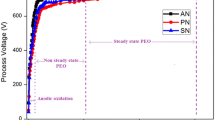Abstract
A novel process route combining electrophoretic deposition (EPD) and ethylene-diamine-tetra-acetic acid (EDTA) complexation has been developed and used to produce crack-free coatings of alkaline earth oxides with thickness up to 8 μm after heat treatment at 700°C. Aqueous systems were found to be unsuitable for the EPD process due to their high conductivity and the effect of liberated gas evolved on the electrodes, and a non-aqueous based alternative formulation was developed based on methanol (solvent/carrier) and ethanediol (stabiliser) in conjunction with the EDTA complexes to allow the EPD process to be successfully used to deposit porous coatings. The coating process has been investigated by electrochemical impedance spectroscopy (EIS), and is thought to involve a combination of the migration of complexed ions in solution, their precipitation as charged colloidal particles in the vicinity of the anode, followed by their aggregation at, and adhesion to the anode surface. It is believed the process may have application for the low cost deposition of a wide range of porous coatings.
Similar content being viewed by others
References
B. M. Weckhuysen, G. Mestl, M. P. Rosynek, T. R. Krawietz, J. F. Haw and J. H. Lusford, J.Physical Chemistry B 102(19) (1998) 3773.
V. R. Choudhary, B. Prabhakar, A. M. Rajput and A. S. Mamman, Fuel 77(13) (1998) 1477.
G. A. Haas, in“Methods of Experimental Physics, ”Vol. 4, edited by V. W. Hughes and H. L. Schultz (Academic Press, New York, 1967) p. 1.
P. Sarkar and P. S. Nicholson, J.Amer.Ceram.Soc. 79 (1996) 1987.
Z. R. Ulberg, Y. F. Deinega and T. J. Kemp, in “Electrophoretic Composite Coatings” (Ellis Horwood, New York, 1992) p. 11.
D. De and P. S. Nicholson, J.Amer.Ceram.Soc. 82 (1999) 3031.
H. Nishimori, M. Tatsumisago and T. Minami, J.Mater.Sci. 31 (1996) 6529.
S. N. B. Hodgson, X. Shen and F. R. Sale, ibid. 35 (2000) 5275.
J. Fransaer, J. R. Loos, L. Delaey, V. D. Biest, O. Arkens and J. P. Celis, J.Appl.Phys. 65 (1989) 3277.
A. Gholinia and F. R. Sale, J.Therm.Anal. 42 (1994) 733.
D. T. Sawyer and P. J. Paulsen, J.Am.Chem.Soc. 80 (1958) 1597.
J. Y. Choudhary, H. S. Ray and K. N. Rai, Trans. J.Br.Ceram.Soc. 81 (1982) 189.
R. Greef, R. Peat, L. M. Peter, D. Pletcher and J. Robison, in “Electrochemistry” (Ellis Horwood, New York, 1990) p. 251.
P. J. Gellings and H. J. M. Bouwmeester, “The CRC Handbook of Solid State Electrochemistry” (CRC Press, Boca Raton, 1997).
Author information
Authors and Affiliations
Rights and permissions
About this article
Cite this article
Hodgson, S.N.B., Shen, X. & Sale, F.R. Electrophoretic deposition of alkaline earth coatings from EDTA complexes. Journal of Materials Science 37, 4019–4028 (2002). https://doi.org/10.1023/A:1019648731836
Issue Date:
DOI: https://doi.org/10.1023/A:1019648731836




